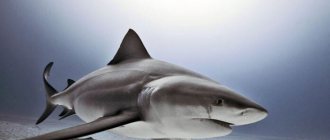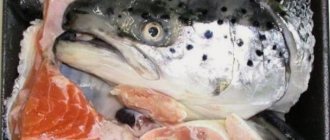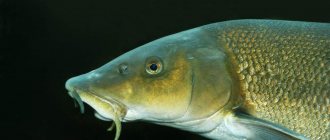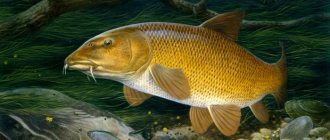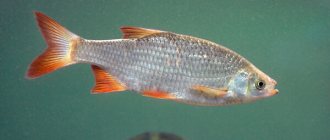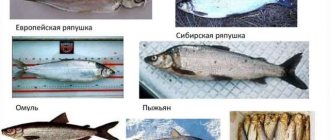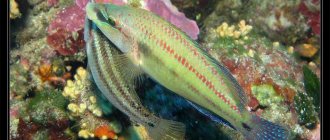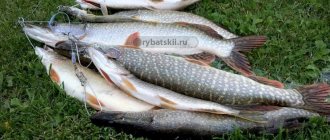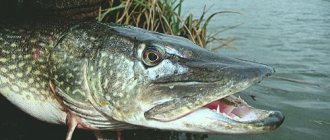Atlantic herring and its other varieties are rightfully included in the menu of national cuisines of many countries.
Many different dishes are prepared from these types of fish - sometimes very exotic, such as the Swedish surströmming, famous for its stunning aroma, or the Jewish forshmak, which has gone from the poor table to the famous gourmet restaurants. And the herring fish has been noted in history, literature, proverbs, and it even has its own holiday: Herring Day is celebrated in the Netherlands and Kaliningrad, and in Finland a festival is held in its honor. Are you preparing salted herring?
- Yes 51%, 275 votes
275 votes 51%275 votes - 51% of all votes
- I buy ready-made 44%, 237 votes
237 votes 44%
237 votes - 44% of all votes
- No 3%, 18 votes
18 votes 3%
18 votes - 3% of all votes
- I don't eat fish 1%, 6 votes
6 votes 1%
6 votes - 1% of all votes
Total votes: 536
03.12.2019
- Yes 51%, 275 votes
275 votes 51%275 votes - 51% of all votes
- I buy ready-made 44%, 237 votes
237 votes 44%
237 votes - 44% of all votes
- No 3%, 18 votes
18 votes 3%
18 votes - 3% of all votes
- I don't eat fish 1%, 6 votes
6 votes 1%
6 votes - 1% of all votes
Total votes: 536
03.12.2019
×
You or from your IP have already voted.
Where does it live in Russia?
Where do herring live in Russia? It is mined in the seas:
- Okhotsk;
- Barentsev;
- Severny;
- Norwegian;
- Bel;
- Azov;
- Caspian;
- Cherny.
Sea herring often feeds in the ocean and goes to rivers to spawn (the Caspian-Black Sea subspecies goes to the freshwater Don, Volga, and Ural regions during the spawning period). It is called a fickle fish - it migrates in huge schools, changing one habitat to another.
Herring, aka the well-known herring
The herring or herring has a laterally flattened body, with the edge of the belly jagged. The scales are most often medium or large in size, but in rare cases they can be small.
The lower jaw is pushed forward in relation to the upper. The mouth is small. If there are teeth, they are not very developed and fall out. The anadromous fin is medium in length, with approximately 80 rays. The dorsal fin is located above the ventral fin. The caudal fin is forked.
The herring genus includes more than 60 species. These fish live in the seas of the temperate and hot zones, and some species are found in the cold zone.
Some representatives of herring are transitional and spawn in rivers, while others are exclusively marine inhabitants and never swim into fresh waters.
Herring (Clupea).
The herring diet consists of a variety of small animals, mostly small crustaceans. This is one of the most numerous genera. Herring plays a vital role in fishing. But some tropical varieties are poisonous due to their diet, so they should not be eaten.
Herring is an extremely useful fish for humans; it is not only used as food, but also for making fertilizers. Some species are the most useful - the most economically valued are true herring, sardines, sprat, aloz, fint, Caspian and Black Sea herring, which live in the seas of Europe and spawn in rivers. Also valuable species include shad and mengaden, living in the rivers of North America. They began to breed shad artificially, and this gave significant results - today it has been possible not only to reduce the decline in fishing on the Atlantic coast of North America, but also to propagate this species on the Pacific coast.
Herring is a traditional holiday fish.
Herring is also an important part of the food chain of predatory fish. In addition, herring is used as bait for catching more valuable species of fish. The most important species is the common herring.
The common herring differs from its closest relative, the sprat, in minor nuances, such as the number of teeth on the ventral edge, but in general these species are very similar. Between them there are a large number of intermediate forms. The largest sizes are Norwegian and Swedish herring; representatives of these species reach a length of 37-42 centimeters. Their back is steel-colored with a bluish, green or golden tint, and their belly and sides are silver. The tail and back fin are dark, and the rest are light.
Herring is a valuable culinary product all over the world. Herring is salted, smoked, baked, etc.
The herring habitat is the Atlantic Ocean, both off the North American and European coasts. In the north they live up to Greenland, and in the south – up to the Baltic Gulf. In the Baltic there lives a small species of herring called herring. Herring is found in the Baltic Gulf and the White Sea, mainly off its southern and western shores.
Herring can have different appearances, but the question of their varieties remains controversial. Most likely, these fish spend most of their lives at considerable depths.
Herring is a tasty sea fish that is very healthy for humans.
Every year in Europe, herring begin to be caught near the Scottish Islands in relatively shallow waters, and then gradually move south. Herring spawning continues throughout the year. Fish eggs are laid in different places. Most often, spawning occurs in two main places. In the Baltic Sea, spawning takes place in summer and autumn, and in the ocean it occurs before the start of winter or at the end of winter. Large females lay eggs at great depths, while smaller ones, on the contrary, are closer to the shore and, as a rule, in less salty water.
During the spawning season, herring gather in huge schools. Sometimes the fish are so densely located in the school that the upper layers come out of the water. During this period, the water becomes cloudy, and an unpleasant odor spreads over a long distance.
When smoked, herring has a special taste; everyone loves this fish!
A huge amount of fertilized eggs sinks to the bottom. The eggs are attached to underwater objects or glued together into clumps. The number of eggs can reach 20-40 thousand. In Baltic herring, the diameter of the caviar varies between 0.9 -1 millimeters, and in the ocean herring, the caviar is slightly larger - 1-1.3 millimeters. The development of eggs usually lasts 2 weeks, but if the temperature is high, the larvae appear within a few days.
Herring feed on small crustaceans, mainly copepods. But they also eat small fish. Research shows that the success of coastal fishing depends on the temperature and salinity of the water; when these indicators are high, large schools of herring swim in such water.
If you find an error, please select a piece of text and press Ctrl+Enter.
Who eats herring
Man, and for many centuries! And the natural enemies of herring in its habitat are all fish and marine mammals that are larger than it: from whales to cod.
Fact. Until the 16th century, herring was considered the food of the poor and monks undergoing asceticism. Wealthy people would never even think of eating it - it was bitter. The person who guessed to remove the gills and rid the herring of bitterness was awarded a monument. This is a simple fisherman from the Dutch village of Bierflint. His name is Willem Jakob Bolkerzoon. He had no idea that he had become the “father” of a gastronomic revolution! Already in the 20th century, the American writer Joseph Heller wrote a book about the role of herring in human history - he believed that it contributed to the development and prosperity of the Dutch economy.
Nutrition of Pacific herring
Pre-spawning activity of herring is April-May. Feeds poorly during spawning from May to late June. They begin to actively fatten from the beginning of July to the end of August. In winter, fish nutrition weakens. Being a predator, it prefers euphausian crustaceans, worms, and calanuses in its diet. Adult Pacific herring contain 25-26% fat. Large Pacific herring, fished from July to October, have a record amount of fat - 32%. Spawning herring have more fat in the head than in the meat.
Reproduction and lifespan
A female herring can spawn up to hundreds of thousands of eggs. On average, about three weeks pass after fertilization, and the larvae hatch from the eggs. Soon after “birth,” future herring already change their living environment: the larvae are carried away by currents far from the mother. Those of them who manage to survive and grow from eight-millimeter crumbs to 5-6 cm, move in huge masses to the coastlines, where they fatten and grow. The seven-centimeter larva also changes its place of residence from one to another - initially by the will of the currents, then, becoming more mature, together with its large flock.
Herring lives on average 6-10 years (if it does not become prey for other fish and mammals that hunt in the water).
Herring spawning period
Herring spawning occurs differently in each area. Off Southern Sakhalin, fish begin to spawn from late March to May. Near Eastern Kamchatka it breeds in May. In Primorye, silverfish spawn in May-June. On the northern shores of the Sea of Okhotsk - from May to July. The spring approach of Pacific herring to the shores occurs in stages. First, mature fish approach, only then young fish. The fertility of the fish is 140 thousand eggs. The incubation period lasts 15-50 days. At the end of spawning, the fish leaves to feed. Returns again in July for fattening.
Extraction methods
This is a fish of great commercial importance. It travels in huge flocks, and a whole fishing fleet goes out to fish: small, medium and large-tonnage vessels. “Little ones” only catch, unloading the catch to floating bases and factories, medium-sized vessels both deliver and process, and heavy-duty fishing trawlers catch, process on site and immediately freeze. They catch all year round, flights last from 2-3 days to 1 or more months. The location of the schools is determined using echo sounders. Fishermen claim that the schools of this fish resemble rocks and reefs under water: there are no other fish that move in such large schools.
They catch her in several ways:
- using two types of seine - ring and purse seine;
- pelagic trawl;
- nets using the driftnet fishing method.
All methods allow you to “capture” a huge number of fish at once - in 3 minutes you can pull out 100 tons, but fishermen try to catch no more than 60-70 at a time, so that the soft fish does not deform under its own weight.
Types of herring with name
There are more than 50 varieties of this fish in the world. Pacific herring and Atlantic herring are two extremely similar species of herring. Previously, the first was called a subspecies of the second; they are similar both in descriptions and in the photo. Experts distinguish them by the number of vertebrae (the first has no more than 55, the second - 55-57) and the keel scales on the abdomen (the second has better developed ones).
Types of Atlantic herring found in our waters:
- Baltic (another name is herring);
- Atlantic-Scandinavian;
- Baltic sprat (it is smaller than the oceanic herring, but belongs to the herring family).
Of particular interest is the Caspian-Black Sea group:
- Kessler (other names - blackback, zalom, king) - from one description and photo of this fish it is clear why today it is an endangered species of herring and is listed in the Red Book: it reaches 52 cm in length and weighs about 2 kg. Fatty and tasty;
- Danube;
- Kerch
- Araucanian herring is found near the coast of Chile and is also a commercial fishery.
Far Eastern
There are three large marine populations of Pacific herring found here:
- Okhotsk;
- Olyutorskaya (aka Corfo-Karaginskaya);
- Gizhiginsko-Kamchatka.
In the south of the Far Eastern waters there are:
- de-castrina;
- Peter the Great Bay;
- Sakhalin-Hokkaido.
Previously, there were more of them, and these were populations known to everyone; today, due to their small numbers, they are known only within the region.
Fact. There are non-ocean fish that are similar to herring, but are mistakenly classified as herring.
- This:
- Pereslavskaya, which lives in Lake Pleshcheyevo - European vendace, belongs to the whitefish;
- Sosvinskaya (lives in the Ob) - also similar, but it is tugun, a relative of salmon.
But the famous (especially in the USSR) Ivasi belongs to the herring family, but in scientific terminology it is called the Far Eastern sardine.
Features and habitat of herring
Herring is the common name for several species of fish belonging to the herring family. All of them are of commercial importance and are caught on a large industrial scale.
The body of the fish is slightly pressed from the sides, and is covered with moderate or large thin scales. On the blue-dark or olive-colored back, one fin is located in the middle.
The pelvic fin grows directly below it, and the caudal fin has a distinctive notch. Along the abdomen, silver in color, along the midline there is a keel consisting of slightly pointed scales. The size of the herring is small, even small. On average, it grows to 30-40 cm. Exclusively migratory fish can grow up to 75 cm.
Large eyes are set deep on the head. Teeth are either weak or completely absent. The lower jaw is slightly better developed and protrudes beyond the upper jaw. Small mouth. Herring can be a sea or river fish. In fresh water it lives in rivers, most often found on the Volga, Don or Dnieper.
In salt water, in impressive schools, it is found in the Atlantic, Pacific and Arctic oceans. It loves temperate climates, so in very cold and hot tropical waters it is represented by a few species.
Pictured is a school of herring
Few people know what kind of fish is called Pereyaslav herring. The funny thing is that she has nothing to do with this family at all, although in appearance she slightly resembles it.
In fact, it is vendace. It was forbidden to catch it, much less sell it, under penalty of death. They ate it only in the royal chambers, at various ceremonies. This famous fish is depicted on the coat of arms of the city of Pereslyavl-Zalessky.
Chemical composition and calorie content
Herring has a rich vitamin and mineral composition. Its main advantage is that it contains high-quality protein and Omega-3 fatty polyunsaturated acids. Protein is easily digestible and is necessary for the construction of cells in the human body (especially for the construction of muscle tissue), and Omega-3 acids are not synthesized by the human body at all, but are necessary for its full development.
Fact. Previously, poorly developing children were given fish oil - this helped saturate the body with Omega-3 acids. Today they are recognized as absolutely necessary and especially important for the development of the human brain, nervous system and eyes.
100 grams of herring contains part of the daily requirement of beneficial vitamins and minerals. This:
- 15% - B6 and riboflavin;
- 46% - D;
- 186% -B12.
- Herring also contains B2, B6, B9, B12, E, PP.
Mineral content per 100 g (in mg):
- K - 310;
- P - 280;
- Na - 100;
- C27H46O (cholesterol) - 90;
- Ca - 60;
- I - 40.
Herring also contains small amounts of iron, sulfur, chlorine and selenium.
The average calorie content per 100 g (more or less depends on the breed of fish and its condition at the time of catching) is 240 kcal. This volume contains 72.3 mg of water, 17.7 g of protein, 19.5 g of fat and 0 carbohydrates.
Fact. Herring caviar is no less healthy: it is rich in vitamins A and D. The first has a beneficial effect on the condition of our skin and hair, the second is important for bones and strong immunity. Caviar also contains useful minerals - just like the herring itself, it contains phosphorus, potassium, calcium, iodine, and iron. In the cuisine of European countries, broken caviar is served in marinade or oil, while in Japan they value the caviar (not freed from the film). The yastyki are not thrown away, but are soaked in a marinade of dashi broth and soy sauce. The Japanese generally highly value herring caviar, using it for nigiri sushi and other national dishes. The roe of other fish is called “sakana no tamago” (the literal translation is simple: “fish eggs”) - but only the herring has earned its own name: “kazunoko” (“inexhaustible”).
Benefits and harms
Beneficial features
It is difficult to find another fish that could boast such a huge number of beneficial properties as herring. There is even a saying in Sweden: “The herring is on the table, the doctor is on the sidelines.” And indeed it is. Numerous studies have proven that herring, due to its high content of omega-3 fatty acids, is very beneficial for the human heart and blood vessels. In addition, it significantly increases the amount of “good cholesterol” in the blood (high-density lipoprotein). Lipoproteins, in turn, significantly reduce the risk of atherosclerosis and other equally dangerous cardiovascular diseases.
It has been proven that healthy herring fat significantly reduces the size of adipocytes (fat cells), which reduces the chance of developing dangerous diseases, including type 2 diabetes. It is worth mentioning that this fish contains active antioxidants. Herring is a “record holder” among fish in terms of vitamin D content (100 grams of herring contains three daily norms of the vitamin), which is simply necessary for bone growth and proper functioning of the kidneys. This vitamin is extremely important for children, especially in winter, when the body suffers from a lack of direct sunlight. Among other things, it has a positive effect on brain function and also improves vision. The fact is that herring is easily digestible by the human body and is an ideal source of protein for it.
Harmful properties
Despite all the beneficial properties of herring, it is necessary to understand that most of us consume it with salt (salted or lightly salted). Therefore, you need to eat it very carefully, because it is known that just 1 gram of salt can bind up to 100 milliliters of liquid. In this connection, doctors advise hypertensive patients, people with diseased kidneys and those who suffer from edema of various natures not to get carried away with herring.
100 grams of lightly salted herring contains approximately 6.3 grams of salt, and Pacific salted herring contains 14.8 grams. Oversaturation of the body with salt causes fluid retention, so the heart has to work harder just to remove excess water and salt.
Beneficial features
Thanks to its excellent taste, herring has received an honorable place in cookbooks in many countries around the world. And its luxurious protein-vitamin-mineral composition makes it a valuable dish for a healthy and wholesome table. The Swedes have a saying: “Herring on the table, the doctor away.” Eating herring helps:
- prevention of cardiovascular diseases;
- maintaining high levels of immunity and hemoglobin;
- effective functioning of the brain and nervous system;
- strengthening skeletal tissues;
- improving the quality of connective tissues.
Herring is one of the healthiest fish. Despite its significant life expectancy, it does not live in ideal conditions, since it is at the bottom of the food chain relative to aquatic inhabitants that are larger than it. She simply does not have time to accumulate in her body toxic substances contained in water, algae, plankton - mercury, heavy metals.
The quality of herring (here the indicators are freshness and individual parts of meat) can correspond to the first or second grade.
First-class herring is fresh, juicy, firm, without damage to the skin or scales. Fish of the second grade may be old - the fats in it have had time to oxidize, and because of them the smell is sour. The surface of the skin of such herring is dull, with a tendency to yellow, slightly damaged, the meat is dry and tough.
Important! Second-rate lightly salted herring may contain pathogenic bacteria - only a strong concentration of salt (10-15%) prevents them from developing. Marinade (a salty-acid solution with the addition of vinegar) does not guarantee the absence of harmful microorganisms: yeast and mold fungi are immune to its effects. It is not recommended to buy such fish. There is one sign of a “morally obsolete” herring (found even in fiction) - “rustiness,” severe yellowing of the skin and part of the scales. Once upon a time, in poor Jewish families, housewives, in order to make such fish suitable for making mincemeat, soaked it for hours in tea leaves. Today there is no need for this - many producers offer high quality fresh and salted fish.
